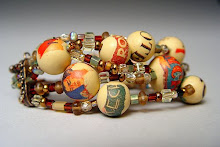In Episode Seven of
Project Runway, the Season 9 designers designed fabrics, created a collection and produced a fashion show. I am acutally going to devote two blog posts to the episode, the first of which will spotlight my visit to
Spoonflower.
In the interest of full disclosure, the fabrics featured on Project Runway Season 9 Episode 7 were designed on HP TouchSmart computers and printed by
Dye-namix, which is located in New York City. Dye-namix’s client list includes Calvin Klein, Coach, J. Mendel, and Ralph Lauren.
Spoonflower makes it possible for the rest of us to design, print, and sell our own fabric. Last spring, I blogged about ordering custom designed fabric from Spoonflower. A couple of weeks ago, after Episode Seven aired, I contacted the company to tell them about my Project Runway Studio 109A challenge. They invited me for a tour of their Durham, NC facility.
My fabric design process started with a vintage image, which I scanned into my computer. I manipulated the image using
Paint.net, a free image and editing software program for computers that run on Windows. After finalizing my image, I created a free account on Spoonflower’s website and uploaded my image.
Once my image was uploaded, I had my choice of fabrics and layout options (centered, basic repeat, half-drop, half-brick, or mirror repeat), which I could preview instantly. I then ordered my design in Spoonflower’s newest fabric, cotton silk.
Spoonflower’s fabrics run anywhere from $18 to $38 per yard, although many of the fabrics come in wide widths. For example, the organic cotton sateen and interlock knit fabrics come in 56 inch widths, while the upholstery weight cotton twill (my favorite) comes in a 58 inch width. I ordered my fabric on a Friday afternoon. Normal shipping times vary (usually from six to seven days), although my fabric was ready by the time I visited Spoonflower on Monday morning.
Spoonflower’s offices are located in a modest office park just outside of North Carolina’s Research Triangle. Lined up inside the lobby are chairs upholstered with fabrics designed by the Spoonflower community which numbers around 150,000 designers from around the world.
Just past the lobby is a warehouse full of fabrics waiting to be shipped and a number of digital textile printers feverishly reeling out design after design. Darci, my tour guide, explained to me that the company prints out around 500 yards of fabric per day and averages 3000 yards ordered per week.
Although the company has been featured in the
New York Times,
Associated Press, Vogue, Martha Stewart Weddings, Make, CRAFT, ApartmentTherapy, Photojojo, and many others, the owners and employees remain humble, yet passionate about the marriage of technology and textiles that is Spoonflower.
Special thanks to Darci and the Spoonflower team for making me feel so welcome. I can’t wait to share with you my design, but you will have to wait until my next post. Until then, auf wiedersehen.






















